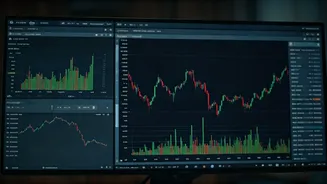Technical Analysis Unveiled
One webinar presented the 'Kagi Charts' technique. This approach, often overlooked, offers a unique perspective on market movements. Kagi charts are a form
of Japanese candlestick charting, but instead of using time as the primary driver of movement, they focus on price reversals. The webinar likely unpacked how these charts reveal potential buying and selling opportunities based on price changes. This involves assessing the strength of trends and identifying key support and resistance levels. Understanding Kagi charts helps in spotting subtle shifts in market sentiment that might be missed by other methods, such as traditional line charts or bar charts. The forgotten technique is being highlighted to help investors find a new and unique way of understanding the markets.
Macro Factors Impact
Another webinar, analyzed the role of macro factors in directing market trajectories. This session probably delved into the complex interplay of economic indicators, geopolitical events, and global policies. It can be understood that discussions on inflation rates, interest rate decisions by central banks, and changes in trade regulations impact market behaviour. Experts would have highlighted how these factors create volatility and affect the valuation of different assets. Inter-market analysis involves studying the relationships between various asset classes, such as stocks, bonds, and commodities, to foresee potential market shifts. The ability to correctly interpret and incorporate these macro factors can significantly enhance investment decision-making.
Gold Investment Strategies
A webinar focused on 'Commodity: Gold Investments'. This is an exploration of gold's role as a safe-haven asset and a hedge against inflation. This likely covered various aspects of gold investment, including physical gold, gold ETFs, and gold mining stocks. The webinar could've reviewed the historical performance of gold during economic uncertainties and periods of inflation, emphasizing its role in portfolio diversification. Experts would have examined the factors influencing gold prices, such as supply and demand dynamics, currency fluctuations, and geopolitical risks. The conversation would've given an overview of different investment strategies tailored to varying risk tolerances and investment horizons, with insights into the benefits and challenges of investing in this precious metal.
Multi-Cap Funds Examined
A Pro Masters webinar explored 'Multicap Funds: A Perfect Balance Between Growth & Stability'. These funds are designed to invest across various market capitalization segments, including large-cap, mid-cap, and small-cap stocks. This approach allows for diversification and the potential to capture growth from different segments of the market. Experts usually discuss how multi-cap funds can provide a balance between stability and high-growth opportunities. The webinar probably delved into portfolio construction, how fund managers allocate assets across different market segments, and the impact of sector allocation on overall performance. Participants also would have received insights into the risk-reward profiles of multi-cap funds.
Swing/Positional Opportunities
The 'Identification of Swing/Positional Opportunities – Charts Insights' webinar would have offered investors and traders methods to uncover short-term gains. Swing trading and positional trading both target profits from short-term market fluctuations, but differ in holding periods. Swing trading typically lasts from a few days to a few weeks, while positional trading can extend to several months. The webinar might have emphasized analyzing chart patterns, technical indicators, and price action to identify potential entry and exit points. Chart patterns such as head and shoulders, triangles, and flags could have been shown. The discussion would have emphasized the importance of using stop-loss orders to limit potential losses and managing risk effectively.
Multi-Asset Allocation Funds
Another webinar explored 'Investing in Multi Asset Allocation Funds'. These funds invest in a range of asset classes, such as equities, bonds, gold, and real estate, aiming for diversification and risk management. This approach allows investors to get a well-rounded portfolio without active management of each asset class individually. Speakers would have discussed how these funds adapt to changing market conditions by dynamically adjusting asset allocation. The session would have probably explained the benefits of diversification, reduced volatility, and the potential to generate steady returns. Experts might have explored the factors that fund managers consider when allocating assets, such as macroeconomic forecasts and market valuations, and how these funds perform relative to other investment strategies.













